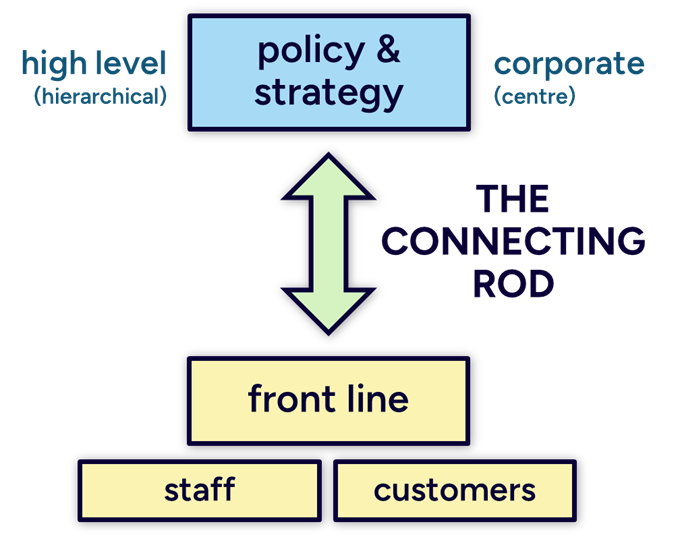Bridging the Gap: Connecting Organisations, Staff, and Customers

Success for organisations, staff, and customers depends on establishing effective connections between these three groups. In an ideal world, each party would work harmoniously towards common goals, creating a thriving environment where everyone wins. However, reality often creates tensions, leading to divides that hinder optimal outcomes. To address these challenges, this article will:
- Explore three common divides between organisations, staff, and customers.
- Leadership Design vs. Front-Line Delivery
- Organisation’s Goals vs. Customer Needs
- Front-Line Staff, Customers, and the Organisation
- Offer practical solutions to bridge these gaps and create stronger connections.
- Highlight the importance of communication, understanding, and validation in fostering a more harmonious and effective environment for all stakeholders.
By understanding these divides and implementing the suggested strategies, businesses can overcome barriers and pave the way for greater success.
The First Divide: Leadership Design vs. Front-Line Delivery
The top-down approach of leadership often focuses on outcomes, while front-line staff are usually focused on the tasks necessary to achieve those outcomes. This difference in perspective creates a divide between the organisation’s big-picture goals and the day-to-day activities of employees.
The Solution
Encourage communication and understanding between leadership and front-line staff. Have senior leadership regularly engage with employees, participate in online drop-in sessions, and invite front-line staff to shadow senior staff at strategic meetings.
The Second Divide: Organisation’s Goals vs. Customer Needs
Organisations often promote customer-centric outcomes but may fail to deliver what customers truly want. Disconnects can occur when staff make assumptions about customer needs, prioritise efficiency over effectiveness, or shape provision based on bias.
The Solution
Ensure the organisation remains customer-focused by actively seeking customer feedback and involving them in decision-making processes. Strive for a workforce that is representative of the communities it serves, and prioritise customer desires over internal assumptions.
The Third Divide: Front-Line Staff, Customers, and the Organisation
Many front-line staff are highly committed to their customers but may not feel the same loyalty towards the organisation. Perceived bureaucracy, lack of resources, and undervaluing staff’s work can create an emotional distance between employees and the organisation.
The Solution
Strengthen the bond between staff and the organisation by recognising and validating the work of front-line employees. Share stories of front-line staff in newsletters, and involve all levels of staff and customers in policy and strategy making.
The Connecting Rod: Initiatives to Bridge the Divides

Preventing and addressing these divides requires investment and commitment from all parties involved. The following initiatives can help build stronger connections between organisations, staff, and customers:
- Senior leadership “walking the floor” to engage with front-line staff.
- Weekly online drop-in sessions for front-line staff to interact with leadership.
- Front-line staff shadowing senior staff at strategic meetings.
- Training workshops designed to foster collaboration, communication, and empathy among staff at all levels, ensuring a more effective and connected workforce.
- Formal and informal acknowledgment, praise, or thanks for front-line staff.
- Highlighting front-line staff in newsletters and multimedia content.
- Involving staff and customers in policy and strategy development.
Embracing eLearning for Enhanced Connections
Another effective way to bridge the divides is by implementing eLearning solutions within the organisation. By offering online training courses and resources, businesses can ensure that staff at all levels have access to the same information, fostering a shared understanding of organisational goals and customer needs. eLearning also provides flexibility for employees, allowing them to learn at their own pace and revisit the material as needed. This approach helps to create a more knowledgeable, connected, and cohesive workforce that is better equipped to serve customers and support the organisation’s objectives.
“By embedding eLearning solutions in our marketing agency, we empower our team with continuous learning opportunities and foster a culture of knowledge sharing. This approach has enhanced our ability to deliver exceptional results for our clients and stay ahead in the dynamic world of digital marketing.” – Ken Davies, Level Marketing
Conclusion
By recognising and addressing the divides between organisations, staff, and customers, businesses can foster stronger connections and achieve greater success. Investing in communication, understanding, and validation can bridge these gaps, creating a more harmonious and effective environment for all stakeholders.
The three key takeaways from this article are:
- Recognise the divides: Understanding the three common divides – between leadership design and front-line delivery, organisations and customers, and front-line staff, customers, and the organisation – can help businesses identify potential issues and address them proactively.
- Invest in connecting strategies: Implement practical solutions, such as regular communication between senior leadership and front-line staff, involving all levels of staff and customers in policy and strategy-making, and acknowledging the efforts of front-line workers. These strategies help bridge the divides and create a more cohesive working environment.
- Nurture a culture of collaboration: By promoting a culture of understanding, communication, and validation, businesses can foster a more harmonious environment for all stakeholders. This will ultimately contribute to better organisational performance, increased employee satisfaction, and improved customer experiences.
About the author – Arnie Skelton (MA, MSc)
CEO, Effective Training & Development Ltd
Arnie Skelton is a Cambridge University graduate, and the founder and CEO of Effective. Over the past 35 years, Arnie has provided professional development for individuals and businesses. He has achieved this through 1-1 coaching, courses, workshops, and ongoing consultancy, helping over 180 clients in the UK and abroad reach their full potential.




